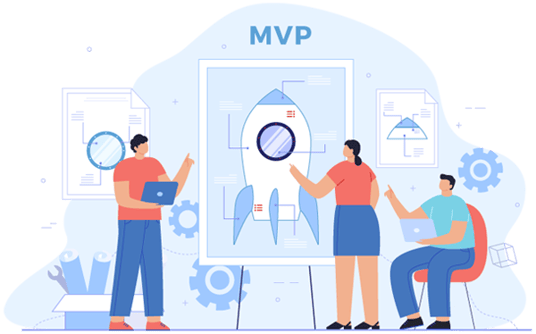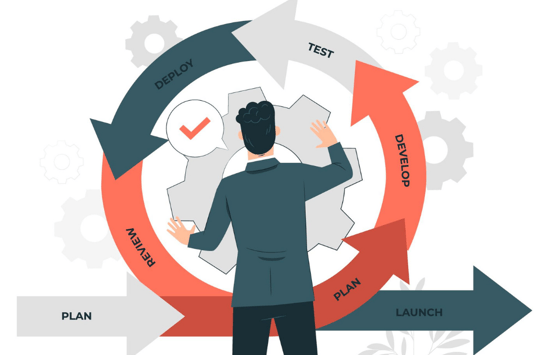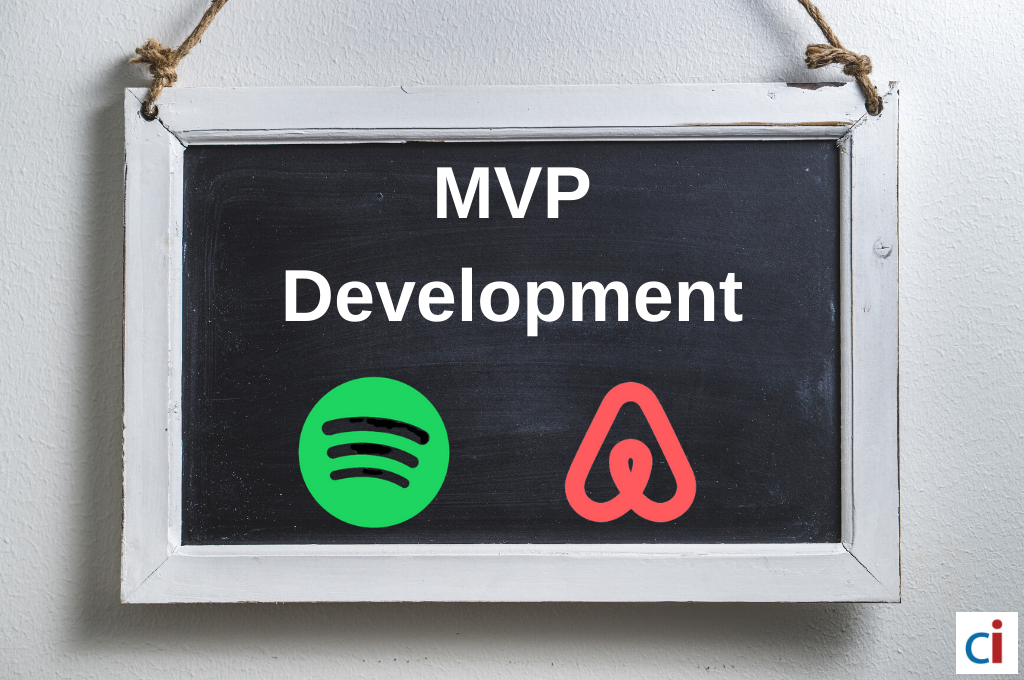Building a minimum viable product is an iterative process. Instead of building in just a single step, you take the build, measure, learn approach.
This goes in circles.
You build the product, collect feedback and user data to measure the success of the MVP. The next step is that you learn from the information received/collected from the first launch. This learning is then applied to the development process to make the next version more lovable for the users. This same approach continues, and the product keeps getting better with each iteration.
You start with getting a clearer understanding of your startup product idea and whether it has a market demand or not. Once you have built your user persona and analyzed the need and the problem that the product aims to solve, you can start with the iteration process.
-
Seed Round Valuation: This is where you bring together the MVP development team to get started and remove any major risk. For those planning to outsource MVP development, you can get started with finding a partner to launch your MVP and get started.
-
MVP Development: You have the team, technology experts, and others so you build the minimum version of your product to be tested on the early adopters or beta testers.
-
Beta Testing: This is where you ask the beta testers to use your MVP and share their opinion. Meanwhile, you also collect their engagement data and other issues while they are using the product.
-
Compiling Feedback: The most important step in the MVP development approach is to compile the feedback and data and analyze it to yield useful insights.
-
Approved Business Model: You analyze the feedback and realize that your business model has been approved in the market. You know that you can scale the product development to get more customers by adding new features & functionalities.
-
Product Scaling: You start accelerating the product development process and add new features to it. The same process of beta testing, feedback compilation/analysis, and development continue to make the product better for the users. You use the compiled feedback to analyze what features need changing and what new ones can be added to improve the overall UX.
Also read: MVP Development For App Startups - What Goes In Building An MVP
Benefits Of MVP Development
The MVP approach has helped several startups succeed. Be it Uber, Airbnb, Spotify, Facebook, or any other new idea, it all started with an MVP. Once you understand the iterative approach that MVP development takes, you need to understand the various benefits that this approach can offer. Let’s get started.
#1. Testing UX Functionality
The role of a graphic designer is crucial in any MVP development team. They design the user experience of the product, which decides the engagement level of the user. Considering the fact that 21% of users abandon an app after the first use, engaging a user is extremely important. Today’s users are digitally conscious beings and demand nothing but the best user experience. They don’t blink an eye before uninstalling an app or deleting a software product if they find even the slightest hint of an unpleasant user experience.
.png?width=536&name=MVP%20development%20guide%20(11).png)
With a minimum viable product, you are able to test your product on real users. This will tell you the bottlenecks, pain points, and issues that a user might experience early on.
The business goal of any new product development is not just to get more downloads but also to retain the users who have downloaded the product. MVP allows you to test the UX functionality on early adopters and improve the experience. You can collect all the data about the user’s interaction with the MVP, the pain points, and other insights to know if they are able to understand the intended flow of the product or not. Based on this, you can continue building and scaling the product.
#2. Analyzing Market Demand
Almost 42% of startups fail because their idea has no market need. They aim too high with an innovative idea without analyzing its market need in the very beginning. They might feel that they’ll be able to solve a market need with their idea, but in reality, this need might not even exist. This is where minimum viable products come into play.
An MVP is a prototype of the main product that helps you give a shape to your idea.

MVP development takes the iterative approach, which allows you to test the idea without investing complete funds. Any business can launch its startup app idea faster with a minimum viable product and test it quickly on the target audience of early adopters. This approach helps in understanding the market demand early on. It prevents any business from investing all its efforts, energy, resources, etc., in one product without knowing if it will be loved by the people or not.
#3. Enticing Early Adopters
Another benefit of using a minimum viable product approach is that it helps in enticing early adopters. These could be your friends, family members, team workers, or other early users of your app. You test your beta version of your product on these early adopters.
The main benefit here is that you need not build the completed product to test it on these early users. All you need is a beta version of the product, and you can share it with the early adopters.
The best part about using an MVP for early adopters is that it is easier to entice them with the main offering. You need to ensure that your minimum viable product is simple yet intuitive to keep the user interested and is displaying the main offering in the best light.
#4. Verifying Monetization Strategy
Having a fail-proof monetization strategy is imperative to enjoy great returns on any product. Today, there are several monetization strategies available in the market. One can choose from completely paid services, freemium options, in-app purchases, ads, and many other options. However, choosing the most effective monetization strategy can be a bit challenging if you have already built your complete product.

With the MVP development approach, you can test which strategy is the best to take for monetization. You can collect feedback from your customer and see if they are ready to pay for the way you have monetized your app. If the monetization strategy gets the required results, you know you can go ahead with it.
#5. Ensuring Cost Efficiency
Product development can take months and might require a complete team of developers, managers, designers, testing engineers, UI/UX experts, technology experts, and many more. This increases the overall cost of launching the product.
With MVP, you need a small team of one junior developer, one mid-level developer, one designer, 1 QA engineer, and a Project manager. And the time taken for developing a minimum viable product is four sprints = eight weeks = 320 hours. This slashes the overall MVP development cost.
For those looking for an even more cost-efficient solution, outsourcing MVP development is the best option. You just pay the developer or team’s per hour salary, hiring cost, and some miscellaneous costs, which amount to around $38,100 for a very simple MVP.
Additionally, MVP development is an iterative process where you can earn revenue from a simpler app, which requires a much smaller investment. Once the product starts generating more profits, you can use the same in adding more features/functionalities to the product over time.
#6. Getting Clarity Around The Product Idea
An MVP needs to work with a strong idea that has the potential to entice users. While building a full-fledged product, other features may overpower the core idea. And you may never get to know if your product idea gained success or not.
With a minimum viable product approach, you offer the simplest version of your product without any clutter. It is the core feature that is built as per the product idea that you have.
#7. Quicker Release
As the world entered the Industry 4.0 revolution, one can see over a hundred thousand Android and iOS apps being released each month. The competition is extremely high, and one needs to ensure that they are able to materialize the idea before your competitor launches something similar.
The faster time-to-market enables you to entice the early adopters. The sooner you are able to launch your product, the easier it will be to get market validation and verify the business idea. You enter the market faster and even get a loyal user base that will stay with your product through the iterative progress as you scale.
Also Read: A Complete Guide To Outsourcing Product Development
#8. Constant Updates As Per Feedback
Customers love it when they are made to feel important. And a great way to do the same is by implementing their feedback in the next releases. MVP development promotes this.

You do not stuff the initial software with all the features you can add to it. However, you evolve iteratively. You have room to evolve and add new features with the later updates. And these features could be the ones suggested by the users that have already used your product. Moreover, you can update your product constantly with the latest technologies to stay ahead and competitive in the techno world.
#9. Progress With Low Risk
Embarking on any new endeavor is a risky business, be it a startup, an SMB, or an enterprise. You might run short of funds midway; you may realize the product has no market demand, your business model might not get you the required returns. There are several risks associated with a new product. An MVP reduces a majority of those potential risks.
Taking the MVP approach means taking it slow to the market. You have the time to analyze all the risks associated with the product to avoid any risky step.
#10. Support The Product Pitch
Most startups receive funding after impressing them with their idea. A minimum viable product increases the chances of impressing the product pitch to get funding.
With an MVP, you can approach the funding provider with more confidence. You are not just presenting a vague idea but a viable product that has been tested and has proved its potential to be successful among early adopters.
An MVP adds substance to the product pitch when preparing for a funding event. You have a working product that materializes your concept. You can create a business case for your product and show the viability of the product to the stakeholders and help them realize what returns they can expect by investing in your idea.
What Makes MVPs So Beneficial?
There are several reasons why minimum viable products act as an accelerator for most startup product success. However, there are three main reasons why one enjoys all the benefits that come with taking the MVP approach. Let’s list them here.
Faster Release
MVPs are faster to release. It is the first and the simplest version of the product, which makes it quicker to build. A simple MVP can be released in 4-12 sprints or 2-6 months. A full product or even an EVP, on the other hand, might take years to perfect and launch.
Considering the highly competitive landscape, launching a product faster is the only route to ensure your idea is not launched by someone else.
Lowered Cost
When you invest in a smaller portion of a product, the cost gets slashed by a large fraction. One can launch a product and entice the early adopters without investing the entire sum in a single go. This helps even fully-funded startups to mitigate risks and put all the funds in a product that might not work later.
Also Read: How Much Does MVP Development Cost?
MVP development requires a smaller team. And as the prototype is a simple version, it can be built with much less expertise. Thus, helping you save costs with MVP.
Iterative Approach
The minimum viable product takes the iterative approach where the product is launched in different versions. This ensures that you are building a product based on feedback received from the users and the data collected from the user.

MVP ensures that you have received validation on the initial product and scale smartly. You know if the market is accepting your product and launch accordingly.
MVP For Startups
With nine out of ten startups failing to succeed, startups must stay wary of the approach they take for their product launch. One wrong move and the entire resources, funding, efforts, and all else might waste.
With the MVP development approach, you are working smart and launching fast. You do not wait to polish the product before launch. Once you realize the market need, you build the simplest version of the product faster and entice the users with the solution you are providing. This helps you build authority and capture an audience base early on.
Once you have received customer validation, you can keep on scaling. That’s what most of the successful startups did!
They started small and, upon receiving validation, continued to build the product. Even negative feedback would not discourage you or list you among the failures if you start small. MVP enables you to pivot early on and take an approach much more loved by the target market.
Startup Solutions Partner For MVP Development
A proven approach for startups to succeed with their product is to join hands with a startup solutions partner who happens to be a trusted MVP development company. Not only can such a company help with the MVP development but also help you scale. You can find technology experts, hire remote developers, get development teams, designers, testers, managers, marketers, and even outsource product development to help you build the product from scratch and assist in post-launch marketing, measuring, and analysis.
Classic Informatics, a leading product & MVP development company, can be your startup solutions partner. You can come to us with your idea, and we can assist you in each step- from ideation to market research to development, launch, and scale. We have over 300 techies on board to bring your idea to life.

























